Project Management Assignment: Risk, Communication and Methodologies
VerifiedAdded on 2023/01/10
|10
|2517
|94
Project
AI Summary
This project management assignment encompasses a detailed examination of key project management elements. The first part focuses on a risk register, including ten documented risks, along with the importance of the risk register within a risk management plan. The second part delves into the necessity of effective and structured communication between project managers and team members, highlighting the potential consequences of communication gaps and the benefits of established communication channels. The assignment also provides a critical analysis of various project management methodologies, including Agile, Waterfall, and PRINCE2, evaluating their strengths and weaknesses, and providing insights into their practical application. The assignment emphasizes practical application and strategic decision-making in project environments.
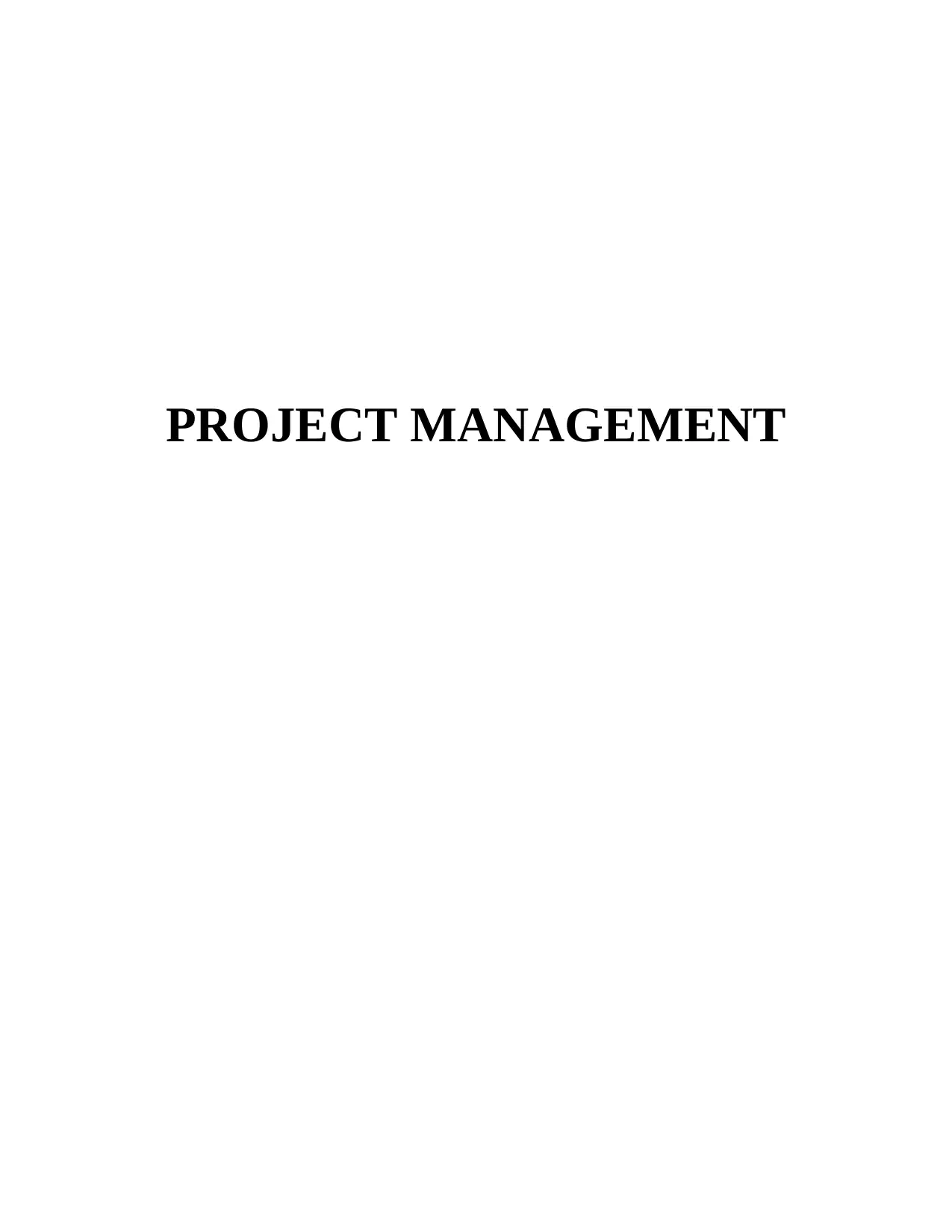
PROJECT MANAGEMENT
Paraphrase This Document
Need a fresh take? Get an instant paraphrase of this document with our AI Paraphraser
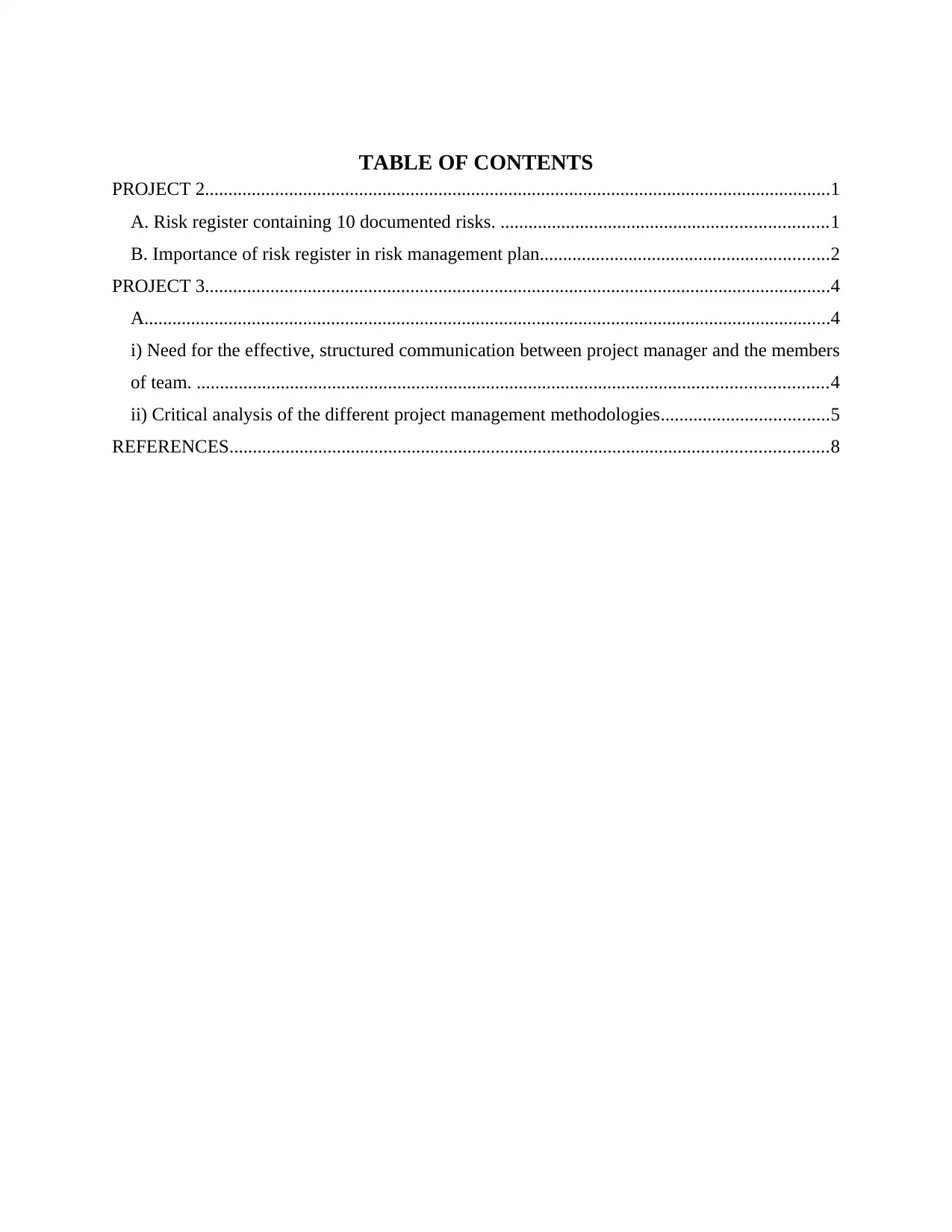
TABLE OF CONTENTS
PROJECT 2......................................................................................................................................1
A. Risk register containing 10 documented risks. ......................................................................1
B. Importance of risk register in risk management plan..............................................................2
PROJECT 3......................................................................................................................................4
A...................................................................................................................................................4
i) Need for the effective, structured communication between project manager and the members
of team. .......................................................................................................................................4
ii) Critical analysis of the different project management methodologies....................................5
REFERENCES................................................................................................................................8
PROJECT 2......................................................................................................................................1
A. Risk register containing 10 documented risks. ......................................................................1
B. Importance of risk register in risk management plan..............................................................2
PROJECT 3......................................................................................................................................4
A...................................................................................................................................................4
i) Need for the effective, structured communication between project manager and the members
of team. .......................................................................................................................................4
ii) Critical analysis of the different project management methodologies....................................5
REFERENCES................................................................................................................................8
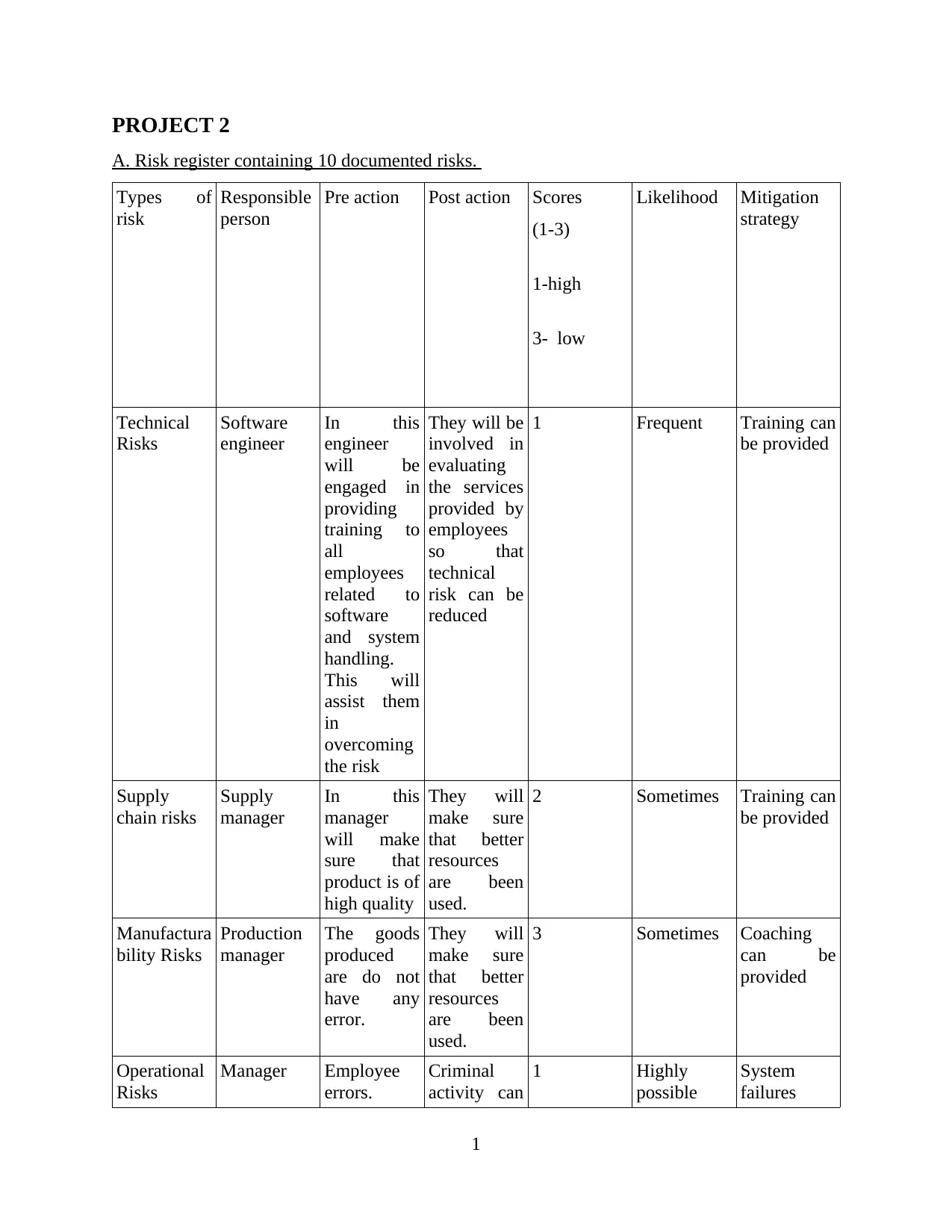
PROJECT 2
A. Risk register containing 10 documented risks.
Types of
risk
Responsible
person
Pre action Post action Scores
(1-3)
1-high
3- low
Likelihood Mitigation
strategy
Technical
Risks
Software
engineer
In this
engineer
will be
engaged in
providing
training to
all
employees
related to
software
and system
handling.
This will
assist them
in
overcoming
the risk
They will be
involved in
evaluating
the services
provided by
employees
so that
technical
risk can be
reduced
1 Frequent Training can
be provided
Supply
chain risks
Supply
manager
In this
manager
will make
sure that
product is of
high quality
They will
make sure
that better
resources
are been
used.
2 Sometimes Training can
be provided
Manufactura
bility Risks
Production
manager
The goods
produced
are do not
have any
error.
They will
make sure
that better
resources
are been
used.
3 Sometimes Coaching
can be
provided
Operational
Risks
Manager Employee
errors.
Criminal
activity can
1 Highly
possible
System
failures
1
A. Risk register containing 10 documented risks.
Types of
risk
Responsible
person
Pre action Post action Scores
(1-3)
1-high
3- low
Likelihood Mitigation
strategy
Technical
Risks
Software
engineer
In this
engineer
will be
engaged in
providing
training to
all
employees
related to
software
and system
handling.
This will
assist them
in
overcoming
the risk
They will be
involved in
evaluating
the services
provided by
employees
so that
technical
risk can be
reduced
1 Frequent Training can
be provided
Supply
chain risks
Supply
manager
In this
manager
will make
sure that
product is of
high quality
They will
make sure
that better
resources
are been
used.
2 Sometimes Training can
be provided
Manufactura
bility Risks
Production
manager
The goods
produced
are do not
have any
error.
They will
make sure
that better
resources
are been
used.
3 Sometimes Coaching
can be
provided
Operational
Risks
Manager Employee
errors.
Criminal
activity can
1 Highly
possible
System
failures
1
⊘ This is a preview!⊘
Do you want full access?
Subscribe today to unlock all pages.

Trusted by 1+ million students worldwide
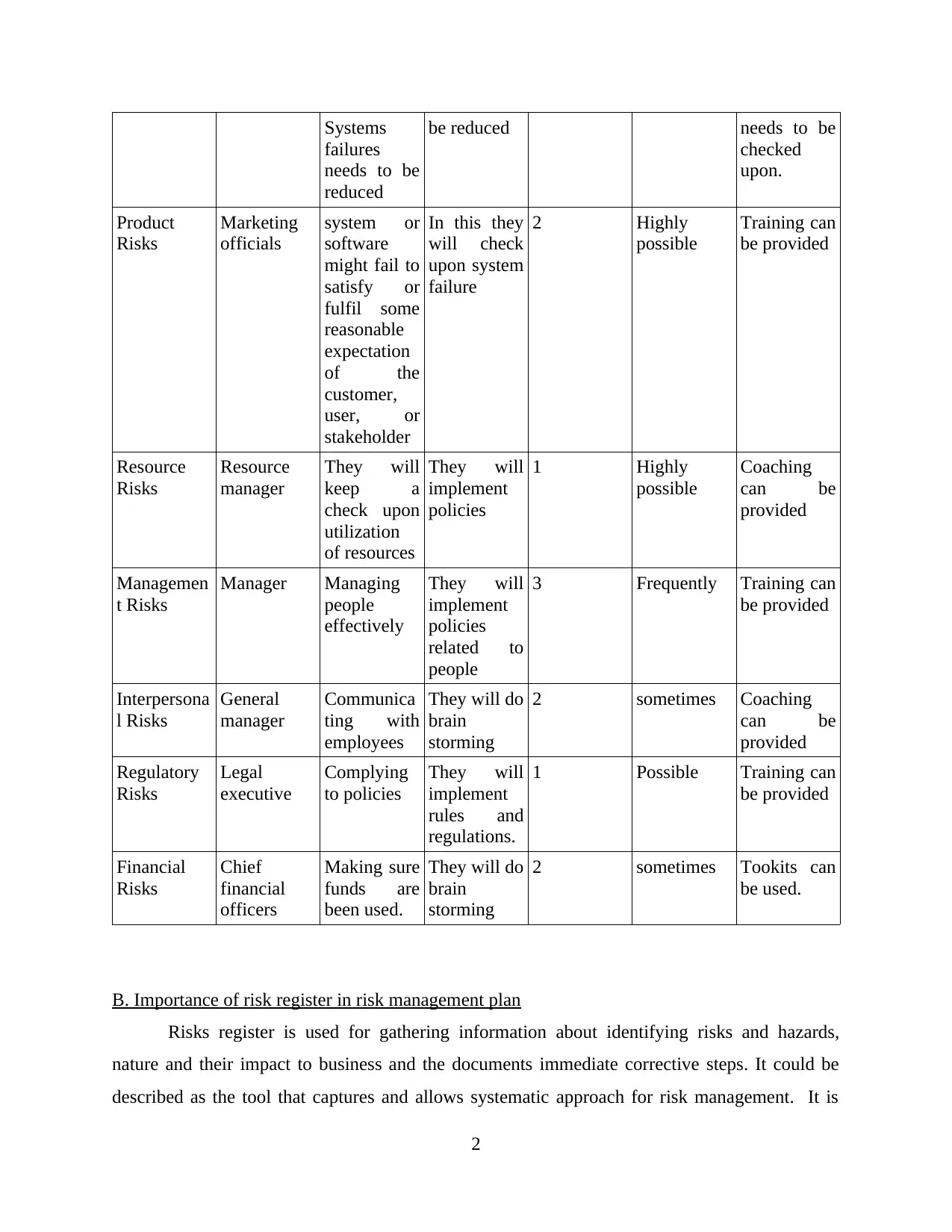
Systems
failures
needs to be
reduced
be reduced needs to be
checked
upon.
Product
Risks
Marketing
officials
system or
software
might fail to
satisfy or
fulfil some
reasonable
expectation
of the
customer,
user, or
stakeholder
In this they
will check
upon system
failure
2 Highly
possible
Training can
be provided
Resource
Risks
Resource
manager
They will
keep a
check upon
utilization
of resources
They will
implement
policies
1 Highly
possible
Coaching
can be
provided
Managemen
t Risks
Manager Managing
people
effectively
They will
implement
policies
related to
people
3 Frequently Training can
be provided
Interpersona
l Risks
General
manager
Communica
ting with
employees
They will do
brain
storming
2 sometimes Coaching
can be
provided
Regulatory
Risks
Legal
executive
Complying
to policies
They will
implement
rules and
regulations.
1 Possible Training can
be provided
Financial
Risks
Chief
financial
officers
Making sure
funds are
been used.
They will do
brain
storming
2 sometimes Tookits can
be used.
B. Importance of risk register in risk management plan
Risks register is used for gathering information about identifying risks and hazards,
nature and their impact to business and the documents immediate corrective steps. It could be
described as the tool that captures and allows systematic approach for risk management. It is
2
failures
needs to be
reduced
be reduced needs to be
checked
upon.
Product
Risks
Marketing
officials
system or
software
might fail to
satisfy or
fulfil some
reasonable
expectation
of the
customer,
user, or
stakeholder
In this they
will check
upon system
failure
2 Highly
possible
Training can
be provided
Resource
Risks
Resource
manager
They will
keep a
check upon
utilization
of resources
They will
implement
policies
1 Highly
possible
Coaching
can be
provided
Managemen
t Risks
Manager Managing
people
effectively
They will
implement
policies
related to
people
3 Frequently Training can
be provided
Interpersona
l Risks
General
manager
Communica
ting with
employees
They will do
brain
storming
2 sometimes Coaching
can be
provided
Regulatory
Risks
Legal
executive
Complying
to policies
They will
implement
rules and
regulations.
1 Possible Training can
be provided
Financial
Risks
Chief
financial
officers
Making sure
funds are
been used.
They will do
brain
storming
2 sometimes Tookits can
be used.
B. Importance of risk register in risk management plan
Risks register is used for gathering information about identifying risks and hazards,
nature and their impact to business and the documents immediate corrective steps. It could be
described as the tool that captures and allows systematic approach for risk management. It is
2
Paraphrase This Document
Need a fresh take? Get an instant paraphrase of this document with our AI Paraphraser
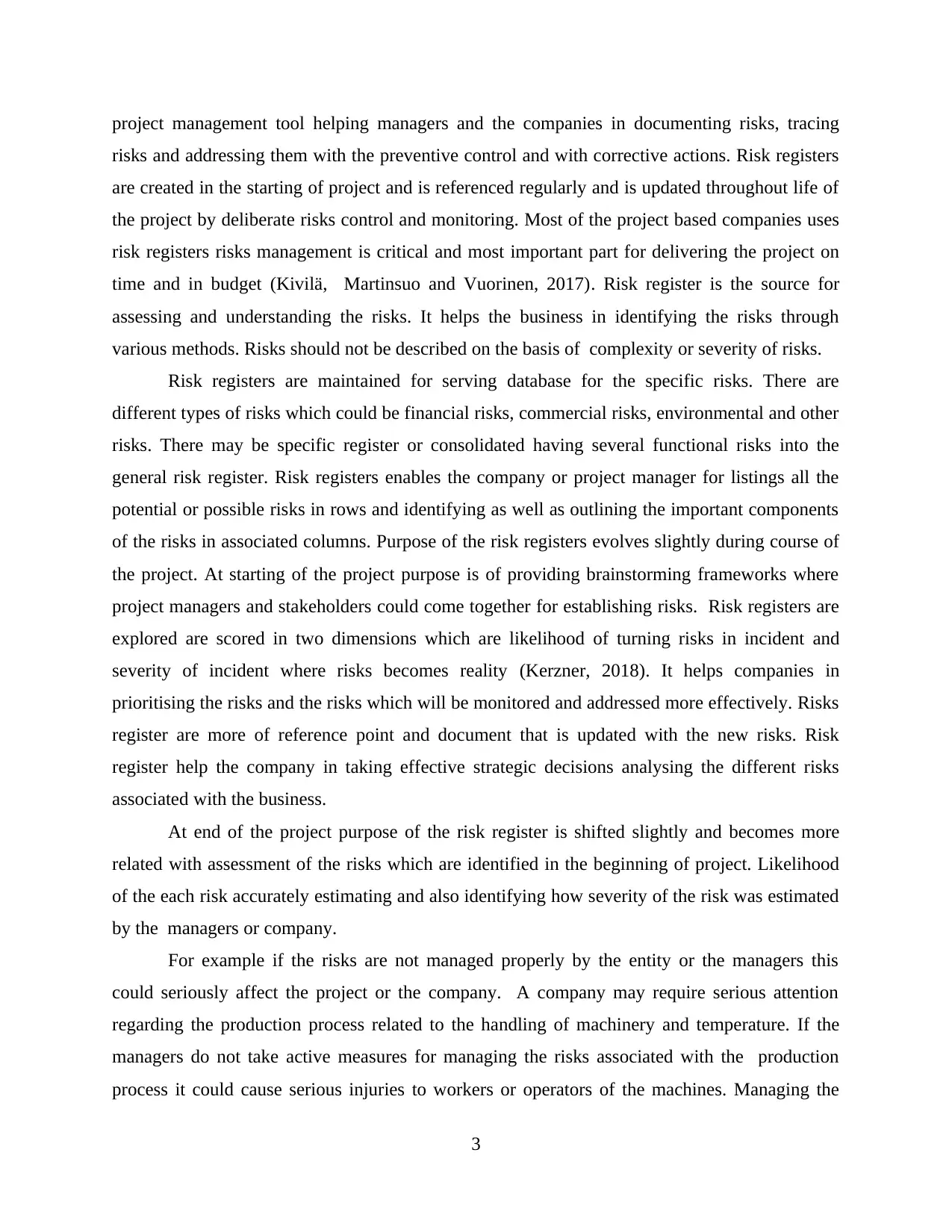
project management tool helping managers and the companies in documenting risks, tracing
risks and addressing them with the preventive control and with corrective actions. Risk registers
are created in the starting of project and is referenced regularly and is updated throughout life of
the project by deliberate risks control and monitoring. Most of the project based companies uses
risk registers risks management is critical and most important part for delivering the project on
time and in budget (Kivilä, Martinsuo and Vuorinen, 2017). Risk register is the source for
assessing and understanding the risks. It helps the business in identifying the risks through
various methods. Risks should not be described on the basis of complexity or severity of risks.
Risk registers are maintained for serving database for the specific risks. There are
different types of risks which could be financial risks, commercial risks, environmental and other
risks. There may be specific register or consolidated having several functional risks into the
general risk register. Risk registers enables the company or project manager for listings all the
potential or possible risks in rows and identifying as well as outlining the important components
of the risks in associated columns. Purpose of the risk registers evolves slightly during course of
the project. At starting of the project purpose is of providing brainstorming frameworks where
project managers and stakeholders could come together for establishing risks. Risk registers are
explored are scored in two dimensions which are likelihood of turning risks in incident and
severity of incident where risks becomes reality (Kerzner, 2018). It helps companies in
prioritising the risks and the risks which will be monitored and addressed more effectively. Risks
register are more of reference point and document that is updated with the new risks. Risk
register help the company in taking effective strategic decisions analysing the different risks
associated with the business.
At end of the project purpose of the risk register is shifted slightly and becomes more
related with assessment of the risks which are identified in the beginning of project. Likelihood
of the each risk accurately estimating and also identifying how severity of the risk was estimated
by the managers or company.
For example if the risks are not managed properly by the entity or the managers this
could seriously affect the project or the company. A company may require serious attention
regarding the production process related to the handling of machinery and temperature. If the
managers do not take active measures for managing the risks associated with the production
process it could cause serious injuries to workers or operators of the machines. Managing the
3
risks and addressing them with the preventive control and with corrective actions. Risk registers
are created in the starting of project and is referenced regularly and is updated throughout life of
the project by deliberate risks control and monitoring. Most of the project based companies uses
risk registers risks management is critical and most important part for delivering the project on
time and in budget (Kivilä, Martinsuo and Vuorinen, 2017). Risk register is the source for
assessing and understanding the risks. It helps the business in identifying the risks through
various methods. Risks should not be described on the basis of complexity or severity of risks.
Risk registers are maintained for serving database for the specific risks. There are
different types of risks which could be financial risks, commercial risks, environmental and other
risks. There may be specific register or consolidated having several functional risks into the
general risk register. Risk registers enables the company or project manager for listings all the
potential or possible risks in rows and identifying as well as outlining the important components
of the risks in associated columns. Purpose of the risk registers evolves slightly during course of
the project. At starting of the project purpose is of providing brainstorming frameworks where
project managers and stakeholders could come together for establishing risks. Risk registers are
explored are scored in two dimensions which are likelihood of turning risks in incident and
severity of incident where risks becomes reality (Kerzner, 2018). It helps companies in
prioritising the risks and the risks which will be monitored and addressed more effectively. Risks
register are more of reference point and document that is updated with the new risks. Risk
register help the company in taking effective strategic decisions analysing the different risks
associated with the business.
At end of the project purpose of the risk register is shifted slightly and becomes more
related with assessment of the risks which are identified in the beginning of project. Likelihood
of the each risk accurately estimating and also identifying how severity of the risk was estimated
by the managers or company.
For example if the risks are not managed properly by the entity or the managers this
could seriously affect the project or the company. A company may require serious attention
regarding the production process related to the handling of machinery and temperature. If the
managers do not take active measures for managing the risks associated with the production
process it could cause serious injuries to workers or operators of the machines. Managing the
3
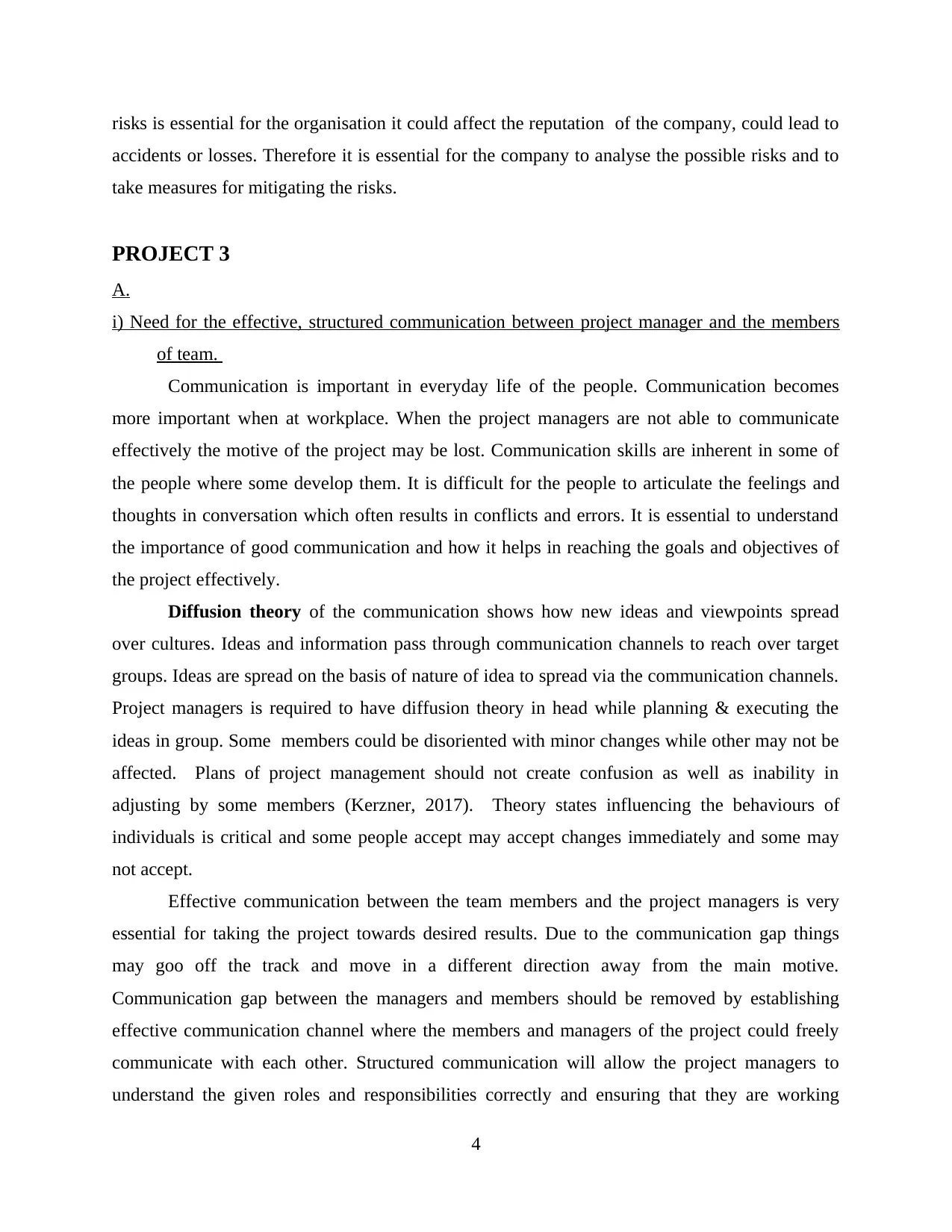
risks is essential for the organisation it could affect the reputation of the company, could lead to
accidents or losses. Therefore it is essential for the company to analyse the possible risks and to
take measures for mitigating the risks.
PROJECT 3
A.
i) Need for the effective, structured communication between project manager and the members
of team.
Communication is important in everyday life of the people. Communication becomes
more important when at workplace. When the project managers are not able to communicate
effectively the motive of the project may be lost. Communication skills are inherent in some of
the people where some develop them. It is difficult for the people to articulate the feelings and
thoughts in conversation which often results in conflicts and errors. It is essential to understand
the importance of good communication and how it helps in reaching the goals and objectives of
the project effectively.
Diffusion theory of the communication shows how new ideas and viewpoints spread
over cultures. Ideas and information pass through communication channels to reach over target
groups. Ideas are spread on the basis of nature of idea to spread via the communication channels.
Project managers is required to have diffusion theory in head while planning & executing the
ideas in group. Some members could be disoriented with minor changes while other may not be
affected. Plans of project management should not create confusion as well as inability in
adjusting by some members (Kerzner, 2017). Theory states influencing the behaviours of
individuals is critical and some people accept may accept changes immediately and some may
not accept.
Effective communication between the team members and the project managers is very
essential for taking the project towards desired results. Due to the communication gap things
may goo off the track and move in a different direction away from the main motive.
Communication gap between the managers and members should be removed by establishing
effective communication channel where the members and managers of the project could freely
communicate with each other. Structured communication will allow the project managers to
understand the given roles and responsibilities correctly and ensuring that they are working
4
accidents or losses. Therefore it is essential for the company to analyse the possible risks and to
take measures for mitigating the risks.
PROJECT 3
A.
i) Need for the effective, structured communication between project manager and the members
of team.
Communication is important in everyday life of the people. Communication becomes
more important when at workplace. When the project managers are not able to communicate
effectively the motive of the project may be lost. Communication skills are inherent in some of
the people where some develop them. It is difficult for the people to articulate the feelings and
thoughts in conversation which often results in conflicts and errors. It is essential to understand
the importance of good communication and how it helps in reaching the goals and objectives of
the project effectively.
Diffusion theory of the communication shows how new ideas and viewpoints spread
over cultures. Ideas and information pass through communication channels to reach over target
groups. Ideas are spread on the basis of nature of idea to spread via the communication channels.
Project managers is required to have diffusion theory in head while planning & executing the
ideas in group. Some members could be disoriented with minor changes while other may not be
affected. Plans of project management should not create confusion as well as inability in
adjusting by some members (Kerzner, 2017). Theory states influencing the behaviours of
individuals is critical and some people accept may accept changes immediately and some may
not accept.
Effective communication between the team members and the project managers is very
essential for taking the project towards desired results. Due to the communication gap things
may goo off the track and move in a different direction away from the main motive.
Communication gap between the managers and members should be removed by establishing
effective communication channel where the members and managers of the project could freely
communicate with each other. Structured communication will allow the project managers to
understand the given roles and responsibilities correctly and ensuring that they are working
4
⊘ This is a preview!⊘
Do you want full access?
Subscribe today to unlock all pages.

Trusted by 1+ million students worldwide
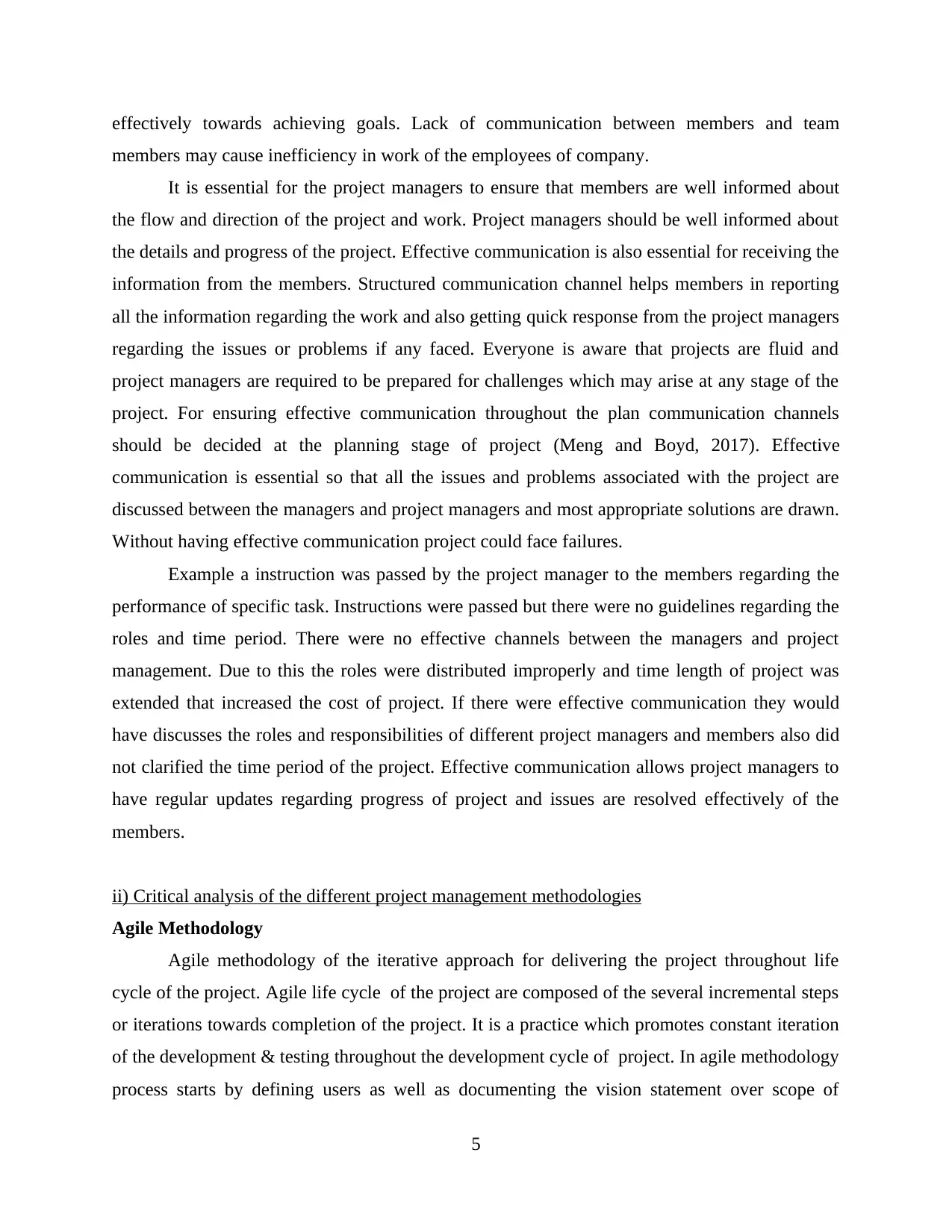
effectively towards achieving goals. Lack of communication between members and team
members may cause inefficiency in work of the employees of company.
It is essential for the project managers to ensure that members are well informed about
the flow and direction of the project and work. Project managers should be well informed about
the details and progress of the project. Effective communication is also essential for receiving the
information from the members. Structured communication channel helps members in reporting
all the information regarding the work and also getting quick response from the project managers
regarding the issues or problems if any faced. Everyone is aware that projects are fluid and
project managers are required to be prepared for challenges which may arise at any stage of the
project. For ensuring effective communication throughout the plan communication channels
should be decided at the planning stage of project (Meng and Boyd, 2017). Effective
communication is essential so that all the issues and problems associated with the project are
discussed between the managers and project managers and most appropriate solutions are drawn.
Without having effective communication project could face failures.
Example a instruction was passed by the project manager to the members regarding the
performance of specific task. Instructions were passed but there were no guidelines regarding the
roles and time period. There were no effective channels between the managers and project
management. Due to this the roles were distributed improperly and time length of project was
extended that increased the cost of project. If there were effective communication they would
have discusses the roles and responsibilities of different project managers and members also did
not clarified the time period of the project. Effective communication allows project managers to
have regular updates regarding progress of project and issues are resolved effectively of the
members.
ii) Critical analysis of the different project management methodologies
Agile Methodology
Agile methodology of the iterative approach for delivering the project throughout life
cycle of the project. Agile life cycle of the project are composed of the several incremental steps
or iterations towards completion of the project. It is a practice which promotes constant iteration
of the development & testing throughout the development cycle of project. In agile methodology
process starts by defining users as well as documenting the vision statement over scope of
5
members may cause inefficiency in work of the employees of company.
It is essential for the project managers to ensure that members are well informed about
the flow and direction of the project and work. Project managers should be well informed about
the details and progress of the project. Effective communication is also essential for receiving the
information from the members. Structured communication channel helps members in reporting
all the information regarding the work and also getting quick response from the project managers
regarding the issues or problems if any faced. Everyone is aware that projects are fluid and
project managers are required to be prepared for challenges which may arise at any stage of the
project. For ensuring effective communication throughout the plan communication channels
should be decided at the planning stage of project (Meng and Boyd, 2017). Effective
communication is essential so that all the issues and problems associated with the project are
discussed between the managers and project managers and most appropriate solutions are drawn.
Without having effective communication project could face failures.
Example a instruction was passed by the project manager to the members regarding the
performance of specific task. Instructions were passed but there were no guidelines regarding the
roles and time period. There were no effective channels between the managers and project
management. Due to this the roles were distributed improperly and time length of project was
extended that increased the cost of project. If there were effective communication they would
have discusses the roles and responsibilities of different project managers and members also did
not clarified the time period of the project. Effective communication allows project managers to
have regular updates regarding progress of project and issues are resolved effectively of the
members.
ii) Critical analysis of the different project management methodologies
Agile Methodology
Agile methodology of the iterative approach for delivering the project throughout life
cycle of the project. Agile life cycle of the project are composed of the several incremental steps
or iterations towards completion of the project. It is a practice which promotes constant iteration
of the development & testing throughout the development cycle of project. In agile methodology
process starts by defining users as well as documenting the vision statement over scope of
5
Paraphrase This Document
Need a fresh take? Get an instant paraphrase of this document with our AI Paraphraser
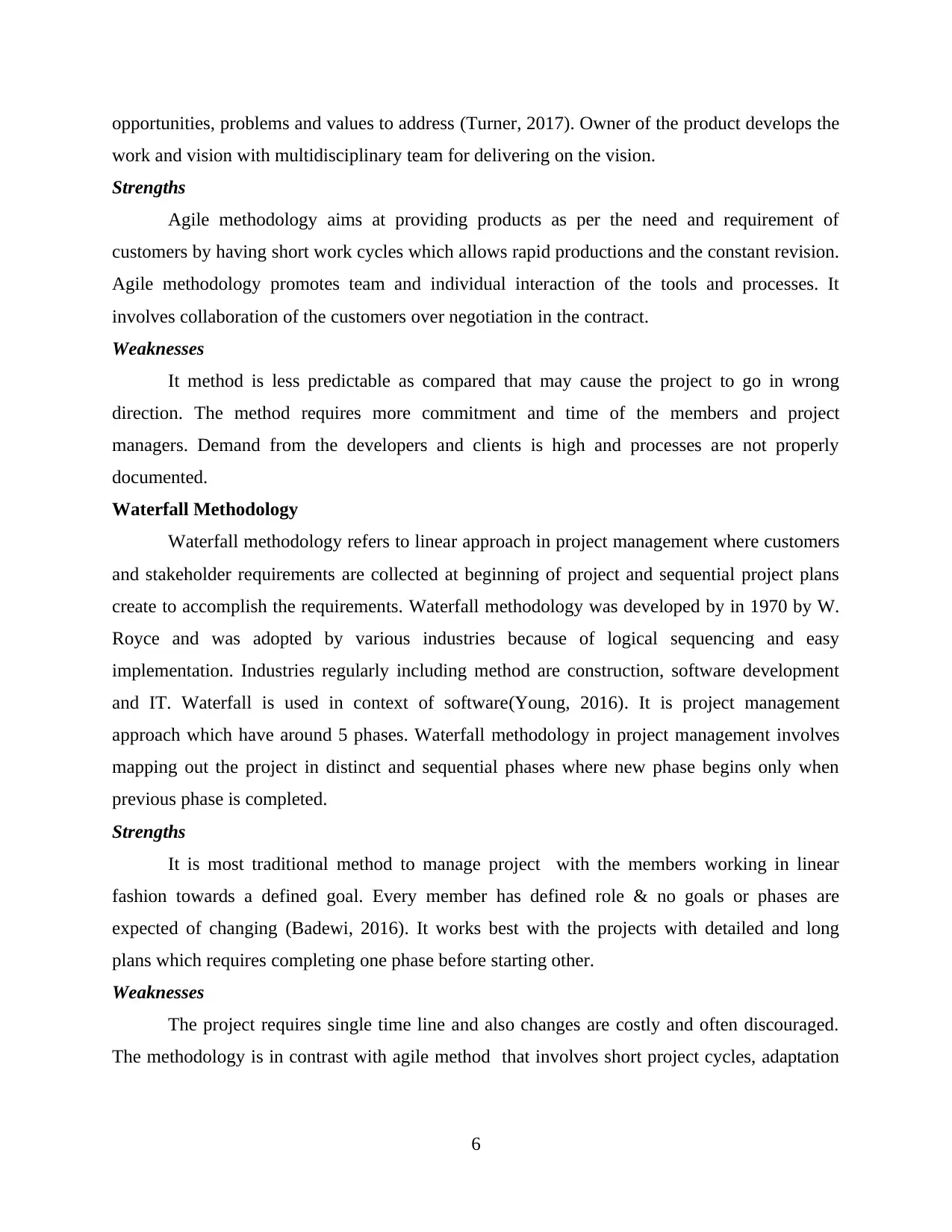
opportunities, problems and values to address (Turner, 2017). Owner of the product develops the
work and vision with multidisciplinary team for delivering on the vision.
Strengths
Agile methodology aims at providing products as per the need and requirement of
customers by having short work cycles which allows rapid productions and the constant revision.
Agile methodology promotes team and individual interaction of the tools and processes. It
involves collaboration of the customers over negotiation in the contract.
Weaknesses
It method is less predictable as compared that may cause the project to go in wrong
direction. The method requires more commitment and time of the members and project
managers. Demand from the developers and clients is high and processes are not properly
documented.
Waterfall Methodology
Waterfall methodology refers to linear approach in project management where customers
and stakeholder requirements are collected at beginning of project and sequential project plans
create to accomplish the requirements. Waterfall methodology was developed by in 1970 by W.
Royce and was adopted by various industries because of logical sequencing and easy
implementation. Industries regularly including method are construction, software development
and IT. Waterfall is used in context of software(Young, 2016). It is project management
approach which have around 5 phases. Waterfall methodology in project management involves
mapping out the project in distinct and sequential phases where new phase begins only when
previous phase is completed.
Strengths
It is most traditional method to manage project with the members working in linear
fashion towards a defined goal. Every member has defined role & no goals or phases are
expected of changing (Badewi, 2016). It works best with the projects with detailed and long
plans which requires completing one phase before starting other.
Weaknesses
The project requires single time line and also changes are costly and often discouraged.
The methodology is in contrast with agile method that involves short project cycles, adaptation
6
work and vision with multidisciplinary team for delivering on the vision.
Strengths
Agile methodology aims at providing products as per the need and requirement of
customers by having short work cycles which allows rapid productions and the constant revision.
Agile methodology promotes team and individual interaction of the tools and processes. It
involves collaboration of the customers over negotiation in the contract.
Weaknesses
It method is less predictable as compared that may cause the project to go in wrong
direction. The method requires more commitment and time of the members and project
managers. Demand from the developers and clients is high and processes are not properly
documented.
Waterfall Methodology
Waterfall methodology refers to linear approach in project management where customers
and stakeholder requirements are collected at beginning of project and sequential project plans
create to accomplish the requirements. Waterfall methodology was developed by in 1970 by W.
Royce and was adopted by various industries because of logical sequencing and easy
implementation. Industries regularly including method are construction, software development
and IT. Waterfall is used in context of software(Young, 2016). It is project management
approach which have around 5 phases. Waterfall methodology in project management involves
mapping out the project in distinct and sequential phases where new phase begins only when
previous phase is completed.
Strengths
It is most traditional method to manage project with the members working in linear
fashion towards a defined goal. Every member has defined role & no goals or phases are
expected of changing (Badewi, 2016). It works best with the projects with detailed and long
plans which requires completing one phase before starting other.
Weaknesses
The project requires single time line and also changes are costly and often discouraged.
The methodology is in contrast with agile method that involves short project cycles, adaptation
6
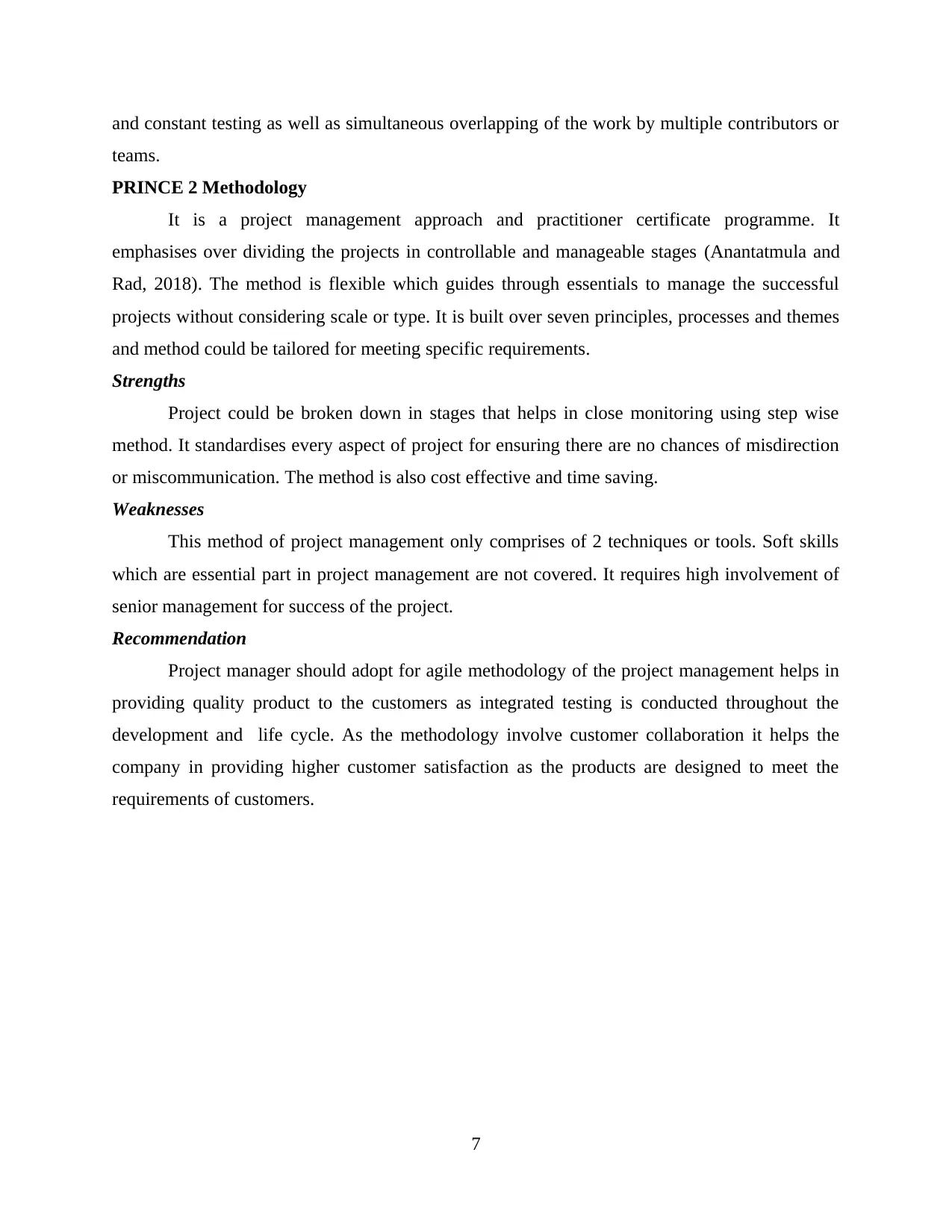
and constant testing as well as simultaneous overlapping of the work by multiple contributors or
teams.
PRINCE 2 Methodology
It is a project management approach and practitioner certificate programme. It
emphasises over dividing the projects in controllable and manageable stages (Anantatmula and
Rad, 2018). The method is flexible which guides through essentials to manage the successful
projects without considering scale or type. It is built over seven principles, processes and themes
and method could be tailored for meeting specific requirements.
Strengths
Project could be broken down in stages that helps in close monitoring using step wise
method. It standardises every aspect of project for ensuring there are no chances of misdirection
or miscommunication. The method is also cost effective and time saving.
Weaknesses
This method of project management only comprises of 2 techniques or tools. Soft skills
which are essential part in project management are not covered. It requires high involvement of
senior management for success of the project.
Recommendation
Project manager should adopt for agile methodology of the project management helps in
providing quality product to the customers as integrated testing is conducted throughout the
development and life cycle. As the methodology involve customer collaboration it helps the
company in providing higher customer satisfaction as the products are designed to meet the
requirements of customers.
7
teams.
PRINCE 2 Methodology
It is a project management approach and practitioner certificate programme. It
emphasises over dividing the projects in controllable and manageable stages (Anantatmula and
Rad, 2018). The method is flexible which guides through essentials to manage the successful
projects without considering scale or type. It is built over seven principles, processes and themes
and method could be tailored for meeting specific requirements.
Strengths
Project could be broken down in stages that helps in close monitoring using step wise
method. It standardises every aspect of project for ensuring there are no chances of misdirection
or miscommunication. The method is also cost effective and time saving.
Weaknesses
This method of project management only comprises of 2 techniques or tools. Soft skills
which are essential part in project management are not covered. It requires high involvement of
senior management for success of the project.
Recommendation
Project manager should adopt for agile methodology of the project management helps in
providing quality product to the customers as integrated testing is conducted throughout the
development and life cycle. As the methodology involve customer collaboration it helps the
company in providing higher customer satisfaction as the products are designed to meet the
requirements of customers.
7
⊘ This is a preview!⊘
Do you want full access?
Subscribe today to unlock all pages.

Trusted by 1+ million students worldwide
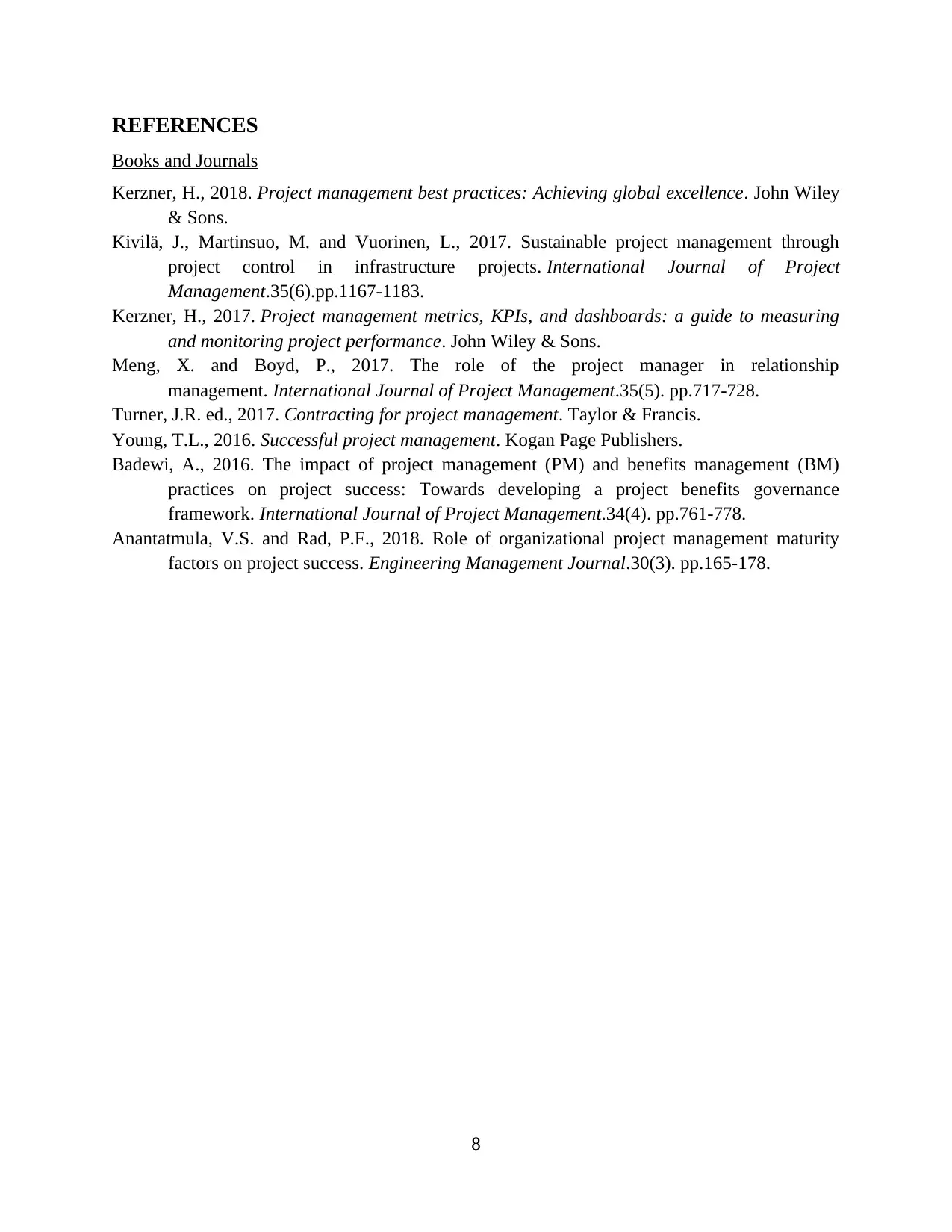
REFERENCES
Books and Journals
Kerzner, H., 2018. Project management best practices: Achieving global excellence. John Wiley
& Sons.
Kivilä, J., Martinsuo, M. and Vuorinen, L., 2017. Sustainable project management through
project control in infrastructure projects. International Journal of Project
Management.35(6).pp.1167-1183.
Kerzner, H., 2017. Project management metrics, KPIs, and dashboards: a guide to measuring
and monitoring project performance. John Wiley & Sons.
Meng, X. and Boyd, P., 2017. The role of the project manager in relationship
management. International Journal of Project Management.35(5). pp.717-728.
Turner, J.R. ed., 2017. Contracting for project management. Taylor & Francis.
Young, T.L., 2016. Successful project management. Kogan Page Publishers.
Badewi, A., 2016. The impact of project management (PM) and benefits management (BM)
practices on project success: Towards developing a project benefits governance
framework. International Journal of Project Management.34(4). pp.761-778.
Anantatmula, V.S. and Rad, P.F., 2018. Role of organizational project management maturity
factors on project success. Engineering Management Journal.30(3). pp.165-178.
8
Books and Journals
Kerzner, H., 2018. Project management best practices: Achieving global excellence. John Wiley
& Sons.
Kivilä, J., Martinsuo, M. and Vuorinen, L., 2017. Sustainable project management through
project control in infrastructure projects. International Journal of Project
Management.35(6).pp.1167-1183.
Kerzner, H., 2017. Project management metrics, KPIs, and dashboards: a guide to measuring
and monitoring project performance. John Wiley & Sons.
Meng, X. and Boyd, P., 2017. The role of the project manager in relationship
management. International Journal of Project Management.35(5). pp.717-728.
Turner, J.R. ed., 2017. Contracting for project management. Taylor & Francis.
Young, T.L., 2016. Successful project management. Kogan Page Publishers.
Badewi, A., 2016. The impact of project management (PM) and benefits management (BM)
practices on project success: Towards developing a project benefits governance
framework. International Journal of Project Management.34(4). pp.761-778.
Anantatmula, V.S. and Rad, P.F., 2018. Role of organizational project management maturity
factors on project success. Engineering Management Journal.30(3). pp.165-178.
8
1 out of 10
Related Documents
Your All-in-One AI-Powered Toolkit for Academic Success.
+13062052269
info@desklib.com
Available 24*7 on WhatsApp / Email
![[object Object]](/_next/static/media/star-bottom.7253800d.svg)
Unlock your academic potential
Copyright © 2020–2025 A2Z Services. All Rights Reserved. Developed and managed by ZUCOL.





